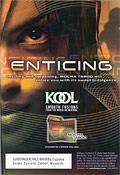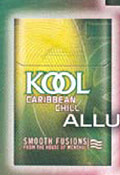Introduction to the Speaker
In 1986, Patrick Reynolds became the first tobacco industry figure to turn his back on the cigarette makers. He’s a grandson of the tobacco company founder R.J. Reynolds, but the family’s cigarette brands, Camel and Winston, killed his father and eldest brother.
Mr. Reynolds’ appearances in the media and before Congress have made him a nationally known and respected champion for a tobacco free society. Former Surgeon General C. Everett Koop has commented, “Patrick Reynolds is one of the nation’s most influential advocates for a Tobaccofree Earth.”
In hundreds of live talks before universities, high schools and middle schools, he has reminded many thousands of students of the dangers of smoking. Mr. Reynolds has devoted his life to furthering the goal of a smokefree society, and motivating young people to stay tobacco and vape free.
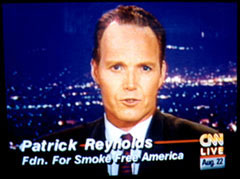
His University lecture and Health Conference keynote combines his skills as a motivational speaker with an up-to-date report on today’s Tobacco Wars.
He covers many of the topics below in his talks.
Jump to our current page for universities and other adult groups. Below are the main points covered in Patrick Reynolds’ 2022 – 2023 talk for adults.
Add on a school assembly program
for a local high school or middle school
View video and audio clips from the bestselling
educational video of his live talk
For our complete information package, click here.
Partner with a local school, hospital, or health department
Guide to finding a local co-sponsor
Below are topics covered in our live program
for Universities, Community Members
and Health Conferences.
TOBACCO WARS!
The Battle for a Smokefree Society
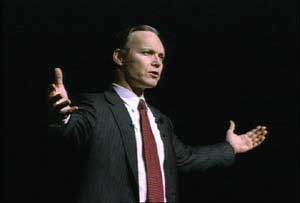
- Patrick Reynolds begins with his personal story, telling how he made the choice to become a tobaccofree advocate. He opens with his memory of watching his father die from smoking when he was a boy. He often asks his audience, “How many of you grew up part of the time without your biological father living at home with you? How do you feel about that? Tonight we are going to connect to our feelings.”
He tells the story of his chance meeting with Senator Robert Packwood during a 1986 tour of Congress. On learning Mr. Reynolds thought the Federal tobacco tax, then 16 cents, should be increased, the Senator invited Patrick to testify before a Congressional committee. Patrick’s Congressional testimony was carried by major news media, and invitations from health groups to speak and lend his support poured in.
In the years that followed he crisscrossed the nation, publicly championing smoking bans, State cigarette tax increases, FDA Regulation of tobacco, and more. As Patrick volunteered for these political campaigns, he became more deeply committed to the tobaccofree cause — and increasingly aware of what the obstacles were to progress for the growing movement for a Tobaccofree Earth.
He noticed that Big Tobacco was one of the top donors to political candidates. Why would a for-profit corporation give away millions and expect nothing in return? In the 2003 – 2004 election cycle, the tobacco industry gave more than $2 million in campaign contributions to Federal candidates. “Nearly all the politicians who accepted campaign donations from Big Tobacco voted the way the tobacco industry wanted them to,” Mr. Reynolds points out. “And 80% of the money went to Republican candidates and PACs. And yes, there are some bad Democrats, too, especially in the tobacco-producing States.
One example: in October, 2004, a House-Senate committee killed a bill in Congress to give the FDA authority over tobacco. Committee members who voted not to let the FDA regulate tobacco received nearly five times as much in tobacco industry PAC contributions ($27,255 average), as those who voted for FDA regulation ($5,505 average), according to a January 2005 report by the Tobacco Free Kids Action Fund and Common Cause. Contributions from 1995 to 2004 were tallied. Scroll down for more about this. Later, FDA Regulation was passed during the Obama Administration.
In March, 2005, a bi-partisan bill was re-introduced in both chambers of Congress to bring about FDA regulation of tobacco. Until then, tobacco has enjoyed the unusual special privilege of escaping significant oversight.
If passed then by Congress, the FDA would have had the authority to:
- Restrict tobacco advertising and promotion further, especially ads appealing to children
- Impede sales to minors
- Reduce or eliminate harmful chemicals in tobacco, to make tobacco products less harmful or less addictive
- Prohibit the unsubstantiated health claims of the so-called “reduced risk” brands, and stop the use of ad slogans like “All of the taste, less of the toxins,” “Reduced carcinogens, premium taste,” and “Less risk of cancer,” and terms such as “light,” “mild,” or “low tar.”
- Ban candy and fruit flavorings in cigarettes
- Require full disclosure of ingredients
- On America’s poly-addictions to cigarettes, food, alcohol, drugs, music, movies, TV — even work and relationships. He asks, “Why are so many of us addicted to one or more of these? The answer is simple: we seek to avoid our pain. When we change our mood with diversions like these, we numb out, shut down and shut out our pain — and we do nothing to solve the problem causing it. Anybody identify with that?”
The solution, he says, is in difficult moments, to avoid substances and other diversions. Instead, stay with the problem. Think about what’s causing your difficulty, try to clearly identify it and be aware of it. Next, talk about it to others. It’s by talking about our problems that we can best solve them, and begin to heal.
Stay with what’s bothering you, talk to a trusted friend, family member or mentor, and then take a step to solve your problem. Taking even a small first step is important.
In short, when life’s problems arise, and they most certainly will, don’t alter your mood with smoking, alcohol, drugs, music, or working too hard. Tough it out, and do the work at hand — to stay with the hard moment, and talk to someone about it.
Life is not meant to be easy. It’s difficult by design. By our personal struggles, we build and define our character. Dealing with life’s obstacles and failures empowers each of us to become stronger, and to reach our full potential as adult men and women. And — you can do it!
100% Statewide Smoking Bans — An Idea Whose Time Has Come
As of 2022, over thirty States have now passed strong statewide laws requiring 100% smokefree restaurants, bars, nightclubs and other workplaces. In 2005, five states joined that list, far more than in any previous year. In 2006, eight more States signed on, and the wave continued in the years that followed. Banning smoking 100% was an idea whose time had come, and it was tremendously popular with most of the electorate as well.
But in some States, governors and Legislatures were very slow to sign on, perhaps because of the power of campaign contributions by Big Tobacco, and pouring far more to defeat ballot measures for State tobacco tax hikes and smoking bans.
In response, the health community, usually led by a coalition of the American Cancer Society, the American Lung Association and the American Heart Association, placed a measure on many State ballots to put smoking bans and State tobacco tax hikes before voters. Even though the tobacco industry far outspent the health community’s meager funding, the voters could not be fooled, and most of the ballot measures passed by landslide margins.
In States which had not yet passed 100% statewide bans in bars and restaruants, local restaurant associations claimed that local smoking bans would hurt their bar and restaurant business. However, studies published in credible medical journals in State after State (MA, CA, ME, and more) actually showed an increase in sales tax revenues in municipalities and States which banned smoking 100%. The fear-mongering Restaurant Associations, often backed by Big Tobacco, were wrong.
It also should be noted that for years, Big Tobacco denied the overwhelming body of scientific and medical evidence that second hand smoke causes lung cancer and heart disease. Their well-compensated spin doctors tried to turn the movement to ban smoking into a freedoms issue, but Patrick Reynolds and others responded, “Your freedom to smoke doesn’t give you the right to make people around you involuntarily breath in secondhand smoke, and face an increased risk of heart disease and lung cancer. According to the EPA, there is no safe level of exposure.”
At the end of his talks, Patrick Reynolds points out during his talk that, “Banning smoking in public areas Statewide is an idea whose time has come. And one day we will have a smokefree society.”
- TOBACCO TAXES
Mr. Reynolds includes a section in his talk about the dozens of State and Federal tobacco tax increases passed in the past 30 years. He argues that they are a win for three reasons:
Less youth smoking: for every 10% increase in the price of cigarettes, there is a 7% reduction in youth smoking, and a 4% reduction in overall smoking.
Needed tax revenue for States Even with smoking declining, recent State tobacco tax increases have been significant enough to help States balance their budgets, pay for some medical services, fund tobacco prevention programs, and more.
Public support Polls show overwhelming popular support for tobacco tax increases. As a result, there is little liability for politicians to vote for them. It’s no wonder that since the start of 2000, more than 42 States have increased their State cigarette taxes. And two weeks after taking office, Obama and the new Democratic majority signed a 69-cent Federal tobacco tax hike into law, after 8 years of annual rejection by the Bush Administration.
In 2006, RJ Reynolds announced it would spend $40 million to defeat ballot measures such as tobacco tax hikes and statewide smoking bans. Later, in California alone RJ Reynolds and Phillip Morris successfully spent $65 million to defeat Proposition 86, a proposed ballot measure to increase California’s tobacco tax by $2.60. Sadly, Big Tobacco’s paid ads on TV convinced voters and won the day. But California later passed another ballot measure to increase its tobacco tax.
Mr. Reynolds asks, should the 19th-century law giving a corporation the same right to freedom of speech as a private citizen? Is private speech really the same as a multi-billion dollar ad campaign by an industry? Mr. Reynolds argues that campaign finance reform is at the core of the matter.
These are questions for students to consider.
President Clinton called for a $1 per pack Federal tax on cigarettes which the Republican-controlled Congress failed to pass. President Bush and his Congress likewise failed to increase the Federal tax, but Obama and the Democratic majority in Congress signed it into law two weeks after taking office, with little support from Republicans.
THE JUDICIAL BRANCH AND VOTERS CAME THROUGH WHEN THE EXECUTIVE AND LEGISLATIVE BRANCHES DID NOT
Along the way, the Courts and voters on ballot measures dealt blows to Big Tobacco when Congress did not. The Judicial Branch of government gave large awards to increasing numbers of individual smokers, and notably, a $246 billion settlement with the States in 1998, to be paid out over 25 years. A coalition of States Attorneys General sued to recover decades of smoking-caused Medicare and Medicaid costs. Since these are 50% funded by the Federal government, in 1999, the Justice Department filed its own lawsuit to recover its share of the costs; this was done at the request of former President Clinton. However the Federal suit was not as successful as the States’ lawsuit, languishing for years under the Bush Administration, which attempted at one point to defund it.
But on the whole, the Judicial branch of our government, free of the influence of campaign contributions, delivered the most victories over the tobacco industry. Congress largely failed to support the fight against Big Tobacco, but that changed under Obama, backed by his Democratic majority in both houses of Congress.
In these years America also saw numerous 100% smoking bans passed by many US municipalities. Notably, city governments are, like the courts, largely free of campaign contributions by Big Tobacco.
Mr. Reynolds also cites a study saying that officials who take tobacco industry money are several times more likely to vote the way Big Tobacco wants them to. “No industry gives away millions of dollars without expecting something in return,” says Mr. Reynolds.
- WHY SHOULD SMOKERS BE ABLE TO SUE BIG TOBACCO?
Mr. Reynolds asks students, “Shouldn’t smokers be held accountable for the disease they brought on themselves by choosing to smoke? I agree, smokers should be accountable. But does that mean the tobacco industry should go unaccountable for their part in the problem?” He continues,
“It’s basic tort law that when a company knows its products are dangerous, it must warn the public about its products. The tobacco industry’s own documents showed that they knew that their products were addictive and caused disease and death, yet they concealed that knowledge, claiming publicly for decades, ‘It’s never been proven that cigarettes cause disease.’
And for years, they targeted youth in their advertising. They used cartoon characters like Joe Camel, and recently, images of DJ’s and rappers on cigarette packaging and other marketing materials. They also used powerful role models for young people, such as the Marlboro Man and images of successful, independent women.
They targeted youth knowing that teens were their most likely new customers. Indeed, studies show that only one smoker in ten starts smoking after reaching age 19. After 19, the tobacco industry is not likely to rope them in.
In a secret meeting in the 1950’s between all the major tobacco companies, tobacco executives agreed to stonewall the truth about the health dangers of smoking. The meeting was held at New York’s Plaza Hotel in the 1950’s. They would later also conceal their knowledge of the addictive properties of nicotine, and deny that second hand smoke was hazardous, when they knew otherwise.
- The Federal Government’s Lawsuit
During his early years in office, President Bush’s budgets made a choice to grossly underfund the lawsuit launched by President Clinton in 1999. Finally, Congress appropriated funding for the US Department of Justice to continue the Federal Government’s case, which seeks to hold the tobacco industry accountable for decades of harmful and illegal practices. These include concealing the health risks of smoking and targeting children in multi-million dollar advertising campaigns. The trial began on September 21, 2004, but was not as successful in the end as the lawsuit by the States. The tobacco industry got off with a lower amount.
Later, many of the restrictions on Big Tobacco sought by the Federal government’s lawsuit were included in FDA Regulation of Big Tobacco, passed into law in 2009 by Obama and the Democratic majority. This brought about new limits on tobacco advertising and marketing.
A Global Initiative: The Framework Convention on Tobacco Control
In response to worldwide tobacco addiction, a global treaty became international law on February 27th, 2005. The Treaty was been signed by 167 nations and ratified by more than 55. The US signed the treaty in April, 2005, but President Bush chose not to send it to the Senate for ratification.
The treaty calls on signatory nations to
- Ban all tobacco advertising and promotion, and to place large, graphic health warnings on the front of cigarette packages. This was not required in nations constrained by their constitution’s Free Speech provision, the US would not comply with this section. This may have been why Bush did not send it to the Senate for ratification.
- Implement laws to protect non-smokers from second hand smoke
- Increase tobacco taxes or raise the price of tobacco, in the case of government-owned tobacco monopolies. This reduces smoking among youth and adults.
- Combat cigarette smuggling and tobacco industry disinformation
- Regulate the ingredients in tobacco products
One outcome of the treaty has been that it helped increase awareness in signing nations among government officials and the public of the need for these tobacco prevention and control measures, and their effectiveness, proven in nations that implemented at least three of them. These nations saw large reductions in smoking rates.
The three measures which have been effective in the US to help bring about declining smoking rates include tax increases, smoking bans and youth prevention programs. The International Framework Convention Alliance helps to inform policymakers about the proven success of these measures.
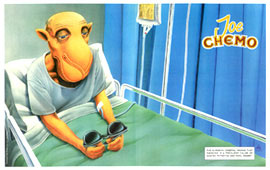
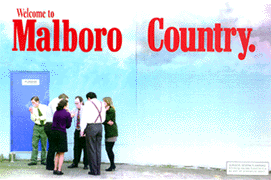
![]()
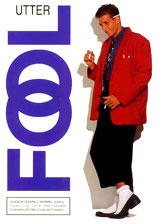
Mr. Reynolds shows these overheads in his video and live talks.
- Advertising: Targeting youth — and women, blacks, Asians, Latinos, and Third World peoples
Cigarette ad campaigns have targeted all these groups; Mr. Reynolds opens students’ eyes to the truth about tobacco ad campaigns which have targeted them. He uses humorous spoofs of cigarette ads, such as Joe Camel above, dying from cancer in a hospital bed. About the Malboro Country ad just above, he points out, “These smokers are gathered outside, because they aren’t welcome inside the building. Today, being a nonsmoker is the norm. If you smoke, you’re often not welcome around others.”
He also shows slides of more recent ad campaigns targeting youth, including several of those below. Seven States Attorneys General have sued to stop the tobacco companies from targeting youth, on the grounds that it violates a deal point in the settlement of the States’ lawsuit against Big Tobacco.
In October, 2006, R.J. Reynolds finally agreed to take its candy-flavored cigarettes almost completely off the market, and to stop running ads associating them with alcoholic beverages.
Ads for R.J. Reynolds Candy-flavored Camel Cigarettes
Click each ad for a larger view.
Ads for Brown & Williamson’s Kool Cigarettes
Click each ad for a larger view.
Ads for U.S. Smokeless Tobacco Co.
Click each ad for a larger view.
- Smoking in Movies and TV
In the 1990’s there was a significant upsurge in the amount of smoking in movies and TV. (See our more detailed page on smoking in TV and films.) Studies showed that characters in the movies are much more likely to smoke than a person in real life. In this way, movies have mislead many teens into thinking that smoking is more popular than it actually is. Even worse, many stars have made smoking look cool to kids when they go to movies.
One effective response is to shine the media spotlight on movie and TV stars who make smoking look cool in their films. Let’s give a dose of healthy shame to producers, directors and stars who make smoking look cool to kids. John Travolta smoked in every film he’d appeared in during the 90’s. Julia Roberts smoked in several of her films, as did other stars — Brad Pitt, Wynona Ryder, and others.
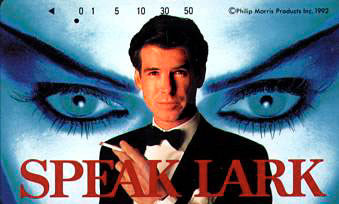
We uncovered this photo of an old ad for Lark cigarettes by Pierce Brosnan, seen in Japan. But Brosnan has since shown tremendous leadership in the Hollywood community, by forswearing smoking in his films. He has set a brilliant example for other stars.
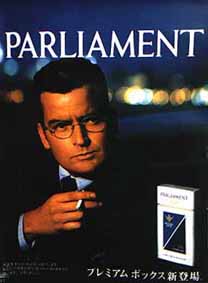
Charlie Sheen’s ad for Parliament ran in Japan. Shame on Mr. Sheen! He set a bad example for youth who look up to him.
Just a few years ago, some producers would take large payments from the tobacco companies to place cigarette brands in films. The producers of License to Kill took a $350,000 payment to have James Bond smoke Larks in the movie — and of course, James Bond is a role model for young boys.
In Superman II, woman reporter Lois Lane, a nonsmoker in the comics, chain-smoked Marlboros, and the Marlboro brand name appeared some 40 times in the film. Tobacco giant Phillip Morris paid a mere $40,000 to the producers for this. Of course, Lois Lane is a role model for young girls.
Sylvester Stallone took a $500,000 payment from one tobacco company to smoke their brand in three of his films. Phillip Morris even placed its products in, astoundingly, Who Framed Roger Rabbit? and The Muppet Movie.
- An Initiation into life
To help prepare students to deal responsibly with tough moments in their lives, and not resort to drugs, alcohol or tobacco, Mr. Reynolds revives the near-universal ancient tradition of Initiation. In this inspiring section near the close of his talk, he points out,
“For many thousands of years, in diverse societies all over the world, the older members of the tribe would take the younger ones out into the forest or desert to initiate them into life. Although there was no radio or newsmedia, tribes all over the Earth engaged in this practice, whether by intuition, common sense, tradition, or some blend of these. This near-universal rite of passage of ancient times has been all but forgotten by our modern society.
“Often initiation would last two days to a week, and it almost always involved inflicting pain on the younger ones, such as a ritual wound or fasting. I believe the core purpose was to let youths know that life would at times be painful, to expect difficulty, and that this is in a normal part of adult life. At the conclusion, most initiation rites would welcome the young to the world of adults.

“So I’m going to take a few moments now, and initiate you. I’m not going to inflict physical pain or have any rituals. I’m just going to inform you, in no uncertain terms, that life will sometimes be painful. It’s designed to be that way… and it’s by our struggles against adversity and to succeed, that we define who we are. And it’s by staying with our pain that we solve the problem and heal — not by running away from it.
“So when difficult moments come, don’t alter you mood and avoid your problems by using cigarettes, or food, alcohol, drugs, TV, music, sex or work — as so many ordinary, uninitiated adults do. Take the harder road. Only a baby gets instant gratification; adults have to delay and wait for it.
“Stay with the problem, talk about it to a trusted friend or mentor, and then take a step to solve it. Often there is healing just in talking about the problem to someone. You can do it — you’re up to the challenge! So stay with the problem and deal with it. Welcome to the world of adults.”
- A 73% upsurge in teen smoking between 1988 and 1998
While youth smoking has been on the decline since 1998, thanks in part to effective new tobacco prevention and education programs in some States, in 1988, Joe Camel was introduced, and between 1988 and 1998, teen smoking soared by 73%. A CDC study suggested that cigarette ad campaigns targeting youth, such as the cartoon camel and the Marlboro Man, were a significant factor in the dramatic upsurge in teen smoking. The study also pointed to a substantial increase in the amount smoking in TV and movies by film stars.
Patrick Reynolds also points to studies showing a keen sense of diminished expectations and heightened anxiety among today’s teens, and that may also be a significant factor.
Mr. Reynolds believes this new anxiety among youth has also helped fuel a rise in teen smoking and campus binge drinking. In a 1999 paper for the Stanford Medical Review, he identified a third possible factor helping explain the increase in youth smoking from ’88 to ’98.
He pointed to market research by Coca-Cola, which showed that “great numbers of young people today suffer from intense anxiety about the future and an acute sense of diminished expectations.” (Time, May 30, 1994). He notes that a Yankelovich Partners study said that 50% of children ages 9 – 17 are “worried about dying young.” (Time, May 3, 1999)
Since September 11th, 2001 and the invasions of Afghanistan and Iraq, many youth were more worried about the years ahead. It is well-documented that following 9/11, there was a significant upsurge in smoking among New York’s teens.
“Believing they face a bleak future,” says Mr. Reynolds, “many of today’s teens may be more prone to engage in high risk behaviors, before an uncertain tomorrow arrives.” This attitude, he says, may have contributed not only to teen smoking rates, but also to drug use and the rise of binge drinking on college campuses.
To counteract this new attitude, he devotes a brief section of his anti-smoking talk to motivating students to believe more strongly in the future.
He does this first by encouraging them to talk to others and not isolate, second to think more positively, and third, to reevaluate what real wealth is. He questions whether wealth is purely about material things. Finally, he inspires students with “my own strong faith in the future — that no matter what, things will eventually be OK.
“I believe that the 21st century will be a truly extraordinary time. So hold on to your health. Don’t smoke, don’t use drugs, and don’t drink, because you’ll need your health — every precious bit of it — for the wondrous and amazing years ahead.”
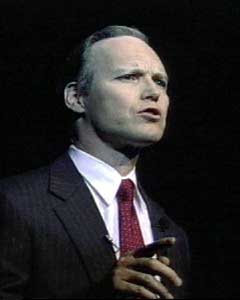
- More about smoking bans In recent years, we have made tremendous strides in our fight against the tobacco industry.
Our greatest progress has come from local governments, which have passed numerous 100% smoking bans, vending machine bans and sales-to-minors compliance checks.
Review: As of the election of November, 2006, seventeen States have now passed strong statewide laws requiring 100% smokefree restaurants, bars, nightclubs and other workplaces. In 2005, five states joined that list, far more than in any previous year. In 2006, eight more States signed on, bringing the current total to 17. Banning smoking 100% appears to be an idea whose time has come, and it is tremendously popular with the public as well.
In some States, governors and Legislatures have been slow to respond, perhaps due to the power of the tobacco lobby andcampaign contributions by Big Tobacco, in the millions annually.
In response, the health community, usually led by a coalition of the American Cancer Society, the American Lung Association and the American Heart Association, often work to place a measure on State ballots, and put the matter before voters. These ballot measures are passing by landslide margins in every election. As this is written, more States are presently in various stages of passing 100% smokefree legislation.
Restaurant associations claimed formerly that smoking bans will hurt bar and restaurant business, but studies published in credible medical journals in State after State (MA, CA, ME, and more) actually showed an increase in sales tax revenues in municipalities and States which banned smoking 100%. The Restaurant Associations, often backed by Big Tobacco, were wrong.
The story in Florida is an example, and became a template which other states would follow. In 2002, a landslide 71% of Florida voters voted for the 100% Statewide smoking ban, which then went to the State Legislature. Despite the public mandate to pass a 100% ban, it did not come from Florida’s legislature or Governor Jeb Bush, possibly because the tobacco industry had been a heavy contributor to the Florida legislature. So Florida’s ban instead came from the voters in a ballot measure initiated by a coalition of the American Cancer Society, the American Lung Association, the American Heart Association, and other groups.
Most State legislatures had passed weaker laws, which allow for smoking in 25% to 50% of restaurant seating areas, with little or no restrictions on bars. Thanks to the tobacco lobby, these Statewide laws often contain a clause preempting local communities from banning smoking 100% in their city, even if the City Council wanted to, the Statewide law would prevail, in States with “preemption.”
Sadly, preemption has been a very effective strategy for Big Tobacco in stopping 100% bans from being passed. In States that are burdened in this way, one of the highest priorities of local tobaccofree groups is to repeal preemption.
As of 2003, only four States have allocated even the CDC’s minimum recommended amount for an effective tobacco education campaign, despite proof that these programs have been spectacularly successful in States that funded them well.
For example, by 2002, Florida’s smoking prevention campaign had achieved a 50% reduction in middle school smoking, and a 35% decrease in high school smoking.
These programs work, but nonetheless forty five States have not even met the CDC’s minimum recommended amount. In 2002-3, a troubling new trend emerged: many States were cutting their already inadequate tobacco education funds to meet budget shortfalls. Several have now securitized all or part of their entire 25 years of settlement payments. This means they took a smaller up front payment, in place of all or some of their future payments. Wisconsin securitized its entire 25 years of settlement payments just to pay down a portion of their 2002 budget shortfall. Twenty five years of potential tobacco education funding simply went up in smoke. Similar measures may be passed in California and other States.
Congress has done little to get in Big Tobacco’s way — Why?
In spite of the overall progress made by other divisions of government — the courts, a very small handful of State legislatures, and many local governments — Congress has done almost nothing to regulate Big Tobacco.
In fact, for more than thirty years, Congress has passed no bill making it harder for children to purchase cigarettes, no laws to limit cigarette advertising, and no Federal workplace smoking law. And for thirty years, Congress has passed no substantial increase in the Federal tobacco tax; the US tobacco tax continues to be among the lowest in the industrialized world.
A clear pattern emerges here: our greatest successes legislatively have been at the local level, in City Halls, and financially, in the Judicial Branch of government, or court system.
State Legislatures and Congress, on the other hand, have too often been strongly influenced by Big Tobacco, and its hired lobbyists and campaign donations, which have little effect over local City Halls and the courts.
Certainly our greatest win came from the Judicial Branch of government, which awarded $246 billion in settlement of the States’ lawsuits. Even though little of the money has been used for youth education and smoking cessation programs, this hurt Big Tobacco both financially, and in terms of its public image.
In March, 2003 Attorney General Ashcroft allowed a $289 billion Federal lawsuit, begun by President Clinton and Janet Reno, to proceed against Big Tobacco. Previously Ashcroft had dragged his feet about letting this case proceed — even under funding the DOJ attorneys pursuing the case, which impeded it for a time. The tobacco industry was the largest political contributor to the Republicans in the last election, and some speculated this was no accident.
“I believe the primary reason for Congress’ stunning leniency on Big Tobacco has been our system of campaign finance,” says Reynolds.
Looking at the larger picture, many other industries have also amassed excessive influence over Congress, through huge political donations and hundreds of hired lobbyists. Mr. Reynolds points out that the large corporations have amassed truly awesome power over our government. The tobacco industry, he says, is a prime example of excessive corporate influence over Congress.
By April, 2002, after the long awaited and bitterly contested passage of Campaign Finance Reform by Congress, more dollars were flowing to our elected officials than ever before. Both parties went on an unprecedented binge of political fundraising, collecting as much as possible before the new bill became law in November, 2002. Since that time, foes have challenged the new law in the courts, and doing their best to weaken the law with loopholes and added rules. And the special interest money, like water finding its way down through the cracks, continues to wend its way to the politicians and parties.
Despite most politicians’ claims that political donations have no effect over the way they vote, no corporate executive gives away millions of company dollars without expecting something substantial in return. Any executive who did would be fired.
Studies show that politicians who have accepted donations from the tobacco companies were several times more likely to vote the way Big Tobacco wanted them to.
Thus our former system of campaign finance effectively helped the tobacco industry elude significant regulation by Congress for many decades.
Mr. Reynolds says that public finance of campaigns, while not perfect, would keep our politicians more honest, and would cost every American just $4.00 each per year. He also believes that the Internet offers some excellent possibilities for reducing the cost of political campaigns.
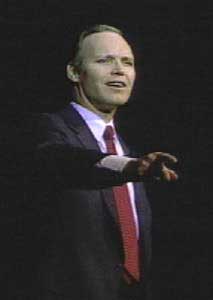
- Is smoking a matter of personal choice? That’s the tobacco industry’s spin, don’t buy it. The truth is, there’s not that much choice once you’re addicted. Admit that; it’s the first step in any 12 Step program for addiction: We admitted we were powerless over nicotine / tobacco / alcohol / drugs / sex — whatever 12 step program you are in.
- Is tobacco a personal freedoms issue? In another spin, the cigarette industry aggressively promoted this idea. But there is little freedom in enslavement to nicotine. And shouldn’t nonsmokers have the freedom to breath clean air? This campaign was an effort by big tobacco to divert our attention away from one basic truth: tobacco is much more a health issue than a freedoms issue.
- Quitting Smoking
What’s the best way to stop smoking? New studies show that smokers not in any program have a 95% failure rate. Smokers who use the patch have a 16% success rate after one year; those who use the antidepressant Zyban have a 25 to 30% success rate after a year; and those who use both have an average 35% success rate. Nicotine replacement products like the patch and gum are sold over-the-counter, while Zyban requires a prescription. For the details of how to quit, see our complete Quit Smoking Tips, or glance over our Boilerplate Points.
- Marketing in the Third World to poor, undereducated peoples. Why did the US Trade Office help Big Tobacco open numerous new markets around the globe?
- Chewing tobacco and countertop displays is always included in Mr. Reynolds’ talk for high schools and middle schools, and some adult groups at the request of the client. In a powerful section on chewing tobacco, Mr. Reynolds shows heartbreaking before-and-after photos of Sean Marsee, who died at age 19 from chewing tobacco — disfigured, sad and in pain. A dramatic and emotional re-telling Sean’s sad story is perhaps the most poignant moment in his live anti-smoking presentations.

Sean Marsee at age 17
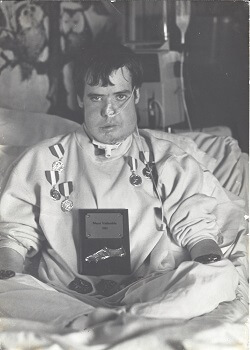
Sean Marsee at age 19,
just prior to his death.
Mr. Reynolds shows these overheads
as he tells Sean Marsee’s story.
Mr. Reynolds goes on to reveal that the only reason self-service displays of tobacco have been placed on countertops everywhere is because the tobacco companies pay each store a monthly fee for every display of tobacco.
The truth is that just a few years ago, almost no one was using chewing tobacco. But many thousands of kids were deceived, and concluded the stores put the displays on counters because the product was really popular and selling well. Seeing these displays daily for years, many eventually got their curiosity up. Many tried it and then got hooked, like Sean.
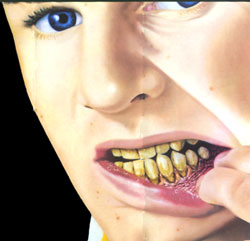
Countertop displays are sometimes right at child eye level, often placed next to the candy. They also face away from the cashier, making tobacco products too easy for kids to shoplift.
“A store might lose $50 per month to shoplifting,” says Mr. Reynolds. But then they are being paid up to $100 per month to keep the display on the countertop. So there’s a stronger financial incentive to keep the display where it is.”
The next challenge: banning all tobacco displays, perhaps as part of the Federal government’s new lawsuit, recently filed by the Justice Department. If tobacco were kept out of sight, under the counter, then only already addicted customers would think to ask for it.
- Cigars There are overlooked health risks. Movie stars have done a great deal to help popularize cigars. Will Smith and Jeff Goldblum in Independence Day, as well as Arnold Schwartzenegger, Bruce Willis, Demi Moore, and Pierce Brosnan, all appeared on the cover of Cigar Aficionado magazine. Their use of cigars makes a powerful statement that is not lost on teens as they browse through the nation’s magazine racks. Cigars cause mouth and throat cancer, as well as poisoning the air with secondhand smoke.
- Why single out tobacco for regulation? Are cars next? Tobacco is set apart from all other products by one fact: it is the only legal product that causes mass addiction, disease, and death when used as intended. Cars, alcohol and other legal products are far safer when used as intended by the manufacturer.
- R.J. Reynolds’ and Philip Morris’ secret papers, revealed in early 1998. One RJR executive wrote, ‘The Camel Brand must increase its share penetration among the 14 – 24 age group — which represent tomorrow’s cigarette business….’ The story of how the whistleblowers brought new evidence to light, adding invaluable fuel to the States’ lawsuits.
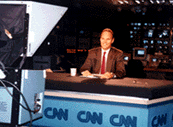
How much government regulation is really necessary? With regard to youth access to tobacco, are common sense and parental guidance enough? Or do we need sting agents to monitor convenience stores, conduct compliance checks, and issue $200 fines to clerks who sell to kids? How would you answer?
Mr. Reynolds says that if parental advice were enough, we would surely not have watched the youth smoking rate soar by 73% between 1988 and 1998. Patrick Reynolds advocates compliance checks (sting operations), but notes, “It wouldn’t take merchants very long to get the idea.”
Since 1998, teen smoking rates have been trending downward, thanks in part to the states which spent millions from their tobacco-generated revenues on comprehensive tobacco prevention programs, which almost always include a paid ad campaign and statewide education in schools.
A study released in October, 2000 showed that States such as California, which have the strongest regulations to curtail youth smoking, have the lowest teen smoking rates — while states such as North Dakota, which have the least regulation, have the highest teen smoking rates. In a stunning achievement, Florida reduced middle school smoking by 50%, since beginning its tobacco education campaign, the Tobacco Pilot Program, initially budgeted at $70 million per year.
- The $246 billion Settlement between the States and Big Tobacco
“The good news is that in April 1999, all outdoor tobacco billboards were taken down for good. Starting in 2000, the use of cartoon characters, and “gear” like T-shirts and baseball hats sporting tobacco logos, also came to an end.
“The four States who settled first — Florida, Texas, Minnesota and Mississippi — received a total settlement of $40 billion, proportionally more than the remaining States later received. Each of the first four agreed to put a significant portion of their settlement money into anti-tobacco counter-advertising, cessation, and school-based tobacco education and prevention programs. Many of their early counter ads attacked the tobacco industry, as California’s pioneering ad campaign had done.
“Florida’s tobacco prevention campaign resulted in the most successful effort ever. By early 2000, there had been a 50% reduction in middle school smoking in Florida as a result of their well-funded program.
Republican Senator John McCain, who was in the news in April, 2001 for bucking his own Party and championing his landmark campaign finance reform bill, in 1997 introduced another visionary bill before Congress. It would have settled all the remaining States’ lawsuits against Big Tobacco.
McCain’s national tobacco settlement bill would have awarded more money, and also contained more teen tobacco prevention money, and stronger limits on tobacco advertising than were later agreed to by the States. But it also would have granted Big Tobacco immunity from all future class action suits.
A little noticed fight broke out at the highest levels of the anti-smoking movement, with the American Lung Association one side, siding with the more outspoken advocates, and the American Cancer Society on the other. The Lung Association objected to giving Big Tobacco any form of immunity from future lawsuits; the Cancer Society was willing to accept immunity in exchange for the huge concessions on advertising which McCain’s bill contained. Another concern many had was that the legislative branch of government was clearly overstepping its Constitutional boundaries, and interfering with the judicial branch. Congress had done next to nothing to regulate tobacco for 30 years, and now they were going to interfere with the courts, where real progress was being made against Big Tobacco.
Pressure built as anti-smoking advocates, including Senator Ted Kennedy, moved to increase the amount of money the tobacco industry would have to pay. Finally, the bubble burst. One tobacco company withdrew from the negotiations, claiming the money requirements would bankrupt them.
Not surprisingly, the coup de grace to McCain’s tobacco settlement bill was administered by his own Republican leadership. Both Trent Lott and Newt Gingrich had been consistent protectors of Big Tobacco, and both were always grateful for the tobacco companies’ enormous campaign contributions to their party. In recent years, 80% of Big Tobacco’s political donations had gone to Republicans. It came as no surprise that Gingrich and Lott found some obscure procedural rules, and used them to effectively kill the bill. McCain’s Tobacco Settlement Deal was dead.
Now that there would be no national deal, the States’ attorneys general held a series of intense meetings behind closed doors. Anti-smoking advocates complained loudly that they had been mostly excluded. Finally, in late 1998, the remaining 46 States signed what became known as the Master Settlement Agreement (MSA).
The MSA did create a national foundation for tobacco education, the American Legacy Foundation in Washington DC. But only $1.45 billion went into it, an amount less than 1% of the total settlement. Although the income from the national foundation is now about $300 million per year, the tobacco industry spent $5 billion on advertising in 1998, and a similar amount in prior years. Then in 1999, they increased it to an astounding $8 billion! Much of that went to keep countertop displays on countertops in grocery and convenience stores. (See tobaccofree.org/children.)
Florida has cut middle school smoking by 50%. These programs work effectively, but only when they are well funded. More of the Tobacco Settlement should also be used to help make up the enormous gap between the $8 billion the tobacco industry spends annually on cigarette advertising, and the $300 million the American Legacy Foundation has to work with annually.
In summary, it’s critical that the States now allocate more funds for tobacco prevention and education. 99% of the settlement money simply went into each State’s general fund, without any requirement to allocate dollars for the kind of tremendously successful youth tobacco prevention programs implemented in Florida. Our next task is to convince our legislators of this need, and that these programs really do work.
In 2000, the American Legacy Foundation began running some hard-hitting ads on national TV. In one TV spot, ‘Body Bag,’ 1200 body bags were piled up outside a tobacco company’s headquarters in NYC, to show tobacco executives what just one day’s US death from smoking might look like.
The Campaign for Tobaccofree Kids reported that as of April, 2001, only 17 States have allocated a substantial portion of their Settlement funds to provide tobacco education and cessation programs, according to CDC recommended guidelines. Few have exceeded the CDC’s minimum recommended amounts.
For the current details of this, a complete description of the tobacco Settlement’s points, as well as a current State by State status report, may be found at the web page, http://www.tobaccofreekids.org/reports/settlements/.
In April, 2001, President Bush’s proposed budget completely de-funded the Federal government’s lawsuit against Big Tobacco. Funding would not be restored until well over a year. At the time, some in the tobacco control community said it could result in a $100 billion savings to Big Tobacco.
The Bush Administration finally changed course, when Attorney General Ashcroft said the Federal government would pursue its suit against Big Tobacco.
During the long process of settling the lawsuits brought by the States against Big Tobacco, there was a move by some in Congress to give the tobacco industry immunity from all further lawsuits. The anti-smoking community was split, as on the plus side, it briefly appeared there would have been more money in the total settlement, and greater concessions on limiting tobacco advertising.
Some tobaccofree advocates said it was unconstitutional for the executive branch of government to interfere so blatantly with the judicial branch. For Congress to legislate immunity for Big Tobacco from further suits seemed to push that boundary, and gave many of us pause — after all, it was the court system, and certainly not Congress, which enabled those of us fighting tobacco to make some of the greatest progress.
Many anti-smoking advocates saw Bush’s move to stall the Federal lawsuit as a brazen protection of Big Tobacco. Bush has hired several people who have worked closely with the cigarette industry, like chief political strategist Carl Rove. While many were dismayed, few in the tobacco control community were very surprised. And only a few spoke out about it.
According to Common Cause, the tobacco companies gave over $5.37 million in campaign donations in 1999 and 2000 — with $4.7 million, or 88%, going to Republicans. Is it really just a coincidence that Bush drastically cut the funding of the Federal lawsuit against Big Tobacco at the time?
No corporation gives away millions of dollars without a good reason. Department of Justice lawyers reported they would need $57 million to continue, but Bush offered just $1.8 million. In truth, this budget point, had it been adopted, would have meant the end of the Federal lawsuit.
The best remedy here is strong, uncompromising campaign finance reform. Fortunately, the McCain-Feingold campaign finance reform bill was been passed by Congress, after numerous attempts to water it down. While the big money is still finding its way to the parties and candidates, it was decidedly a step in the right direction, in this advocate’s opinion. Opponents have sued to undo the bill (see the subtitle near the top of this page in red, A Pattern Emerges.)
Looking at the public perception of the tobacco lawsuits, many people feel that smokers should be accountable for the disease and death they bring on themselves by their choice to continue to smoke. They should, no question.
But does that mean we should let the tobacco industry go unaccountable for its part in causing the problem? They targeted young people in their ad campaigns, they failed to warn of the addictiveness of their products, and for years they claimed publicly that smoking doesn’t cause disease.
As to the ‘choice’ to smoke, for many, smoking is a nearly unbeatable addiction, and there is far less choice than the tobacco companies have suggested to their customers. Eighty percent of smokers became addicted before reaching age 19, and cigarettes are as addicting as heroin, according to Dr. Koop’s report.
Looking at the bigger picture, it’s significant that it’s not Congress who is bringing Big Tobacco to heel. It’s the judicial branch of government, and local coalitions.
For 30 years, Congress has passed no Federal workplace smoking law, no laws making it harder for kids to buy cigarettes, no limits on tobacco advertising, and no substantial Federal cigarette tax increase. I believe the primary reason for this is our present system of campaign finance and special interest lobbying.
It’s ominous that multinationals like Big Tobacco can acquire this much power over our Federal government. Until campaign finance reform is passed, the court system is perhaps our best means of ensuring that fewer of our children become addicted to smoking.
This is a sad moment for all of us fighting to keep our kids off cigarettes.
- THE COMING SMOKEFREE SOCIETY
A moving closing vision and promise: families will no longer burdened with premature deaths of loved ones from smoking, and we will see a society without tobacco in the 21st Century
- Q & A SESSION
- RECEPTION following the talk, if desired
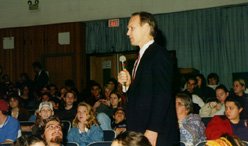
What people are saying about
TOBACCO WARS!
The Battle for a Smokefree Society
See also our Clients page
“Students, faculty, and community members were unanimous in their praise of his excellent talk.”
The University of California at Arvin
“A superb and timely program, enthusiastically received, with a house filled to overflowing, and excellent TV, radio and newspaper coverage!”
John Groves, Augusta College
“Thank you for the magnificent presentation you made at our launch meeting for our nicotine patch, Habitual. Your unique perspective, coupled with honest and forthright communications skills, touched the hearts of the 1500 folk present. The standing ovation midway through said it all.”
Joe Back, CAB Geiger Pharmaceuticals
“Not only did you give us a successful event, but you gave a great boost to our public image. The TV media strongly covered your visit, and so you have had Mississippi College’s name before the public a great deal. The print media also gave us a lot of ink, with a front section-page feature story which took up three quarters of the page! I cannot imagine what all that would have cost us, if it were even buyable!”
Tom Washburn, Mississippi College
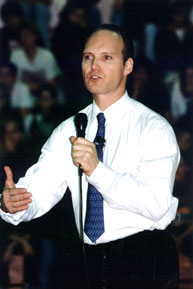
“Our conference was a huge success, in large part due to your participation. You were highly motivating; all left the conference with renewed strength. And what successful media coverage! We had several TV stations, radio stations, and the state’s largest newspaper. To say the least, I am very pleased.”
Neil Hann, The Oklahoma Dept of Health
“Your presentation went over very well. People remember concepts when emotional pictures are created and linked together to illustrate a point. This is what you do so well. When people are moved emotionally, they will remember, and they will take action. The audience loved this emotional link, as I did, with a splash of humor thrown in here and there. Nice touch. I was also impressed with your knowledge and delivery. Your presentation was sincere and heartfelt, as well as humorous and informative. For these reasons, it was most enjoyable. I will be talking to our marketing and public relations departments regarding your talk. Thank you again for a wonderful presentation.”
Kim Aumais Hoechst, Marion, Roussel Pharmaceuticals
“The Kickoff was a great success as evidenced by the media coverage (TV, radio, newspaper) that participated. Your presentation was the highlight of the afternoon’s agenda, and you were definitely the person who drew the media coverage.”
Tom Uram, County of Orange
“An extremely powerful lecture which drew a large crowd and a front page story. He was personable, knowledgeable, and professional, and attracted people from all sections of the community.”
Jarrod Harrison, Modesto College
“Attendance was outstanding, and the media coverage — TV, radio, and newspapers — was terrific!”
Julie Patzwald, California State University
“Inspirational!”
The Governor of Maryland
“What a speaker! He was dynamic and highly knowledgeable, and what media coverage! I want to have him back.”
The Medical College of Georgia
For info on Mr. Reynolds’ talks for middle and high schools, please click here.
FOR HEALTH CONFERENCES
Mr. Reynolds motivates health conference attendees with a powerful acknowledgment of the importance of their work. This instills a renewed sense of pride; some have written that they left his talk with “a feeling of being renewed and refreshed.” He also speaks about the accomplishments of the client’s organization, and points out that each individual is a model for ethical leadership within the group. “Your actions lead your co-workers in a good direction, through the examples you set. You may think they’re small, but they’re not. The fact is, you set an example for the whole area where you live,” he says. “You truly are leaders of your community.” He reminds each health worker how valuable and vital their contribution is, and that they are indeed making a difference. He closes with a promise of the coming smokefree society, and says, “You are men and women who have chosen to devote your lives to improving and maintaining the health of your community. When the smokefree society arrives at last, it will happen because of your work and dedication. History will remember that it happened because of you.”
FOR UNIVERSITIES
Patrick Reynolds’ University talk empowers students at all levels to defend themselves against the onslaught of tobacco advertising and social pressures to smoke.
This program generally runs 90 minutes — 45 minutes of lecture, and 45 minutes of Q & A. Following the Q & A program, Mr. Reynolds likes to invite those interested to join him for an informal reception so he can meet them personally, and so interested community members can meet and exchange cards. Often there is an informal dinner afterward with members of the student government or conference.
He opens students’ eyes to the facts — how for decades, multi-billion dollar cigarette ad campaigns targeted women, teens, blacks and other minority populations, and continue to target poor, uneducated peoples in the Third World.
He explains the importance of the laws limiting second hand smoke. At Universities, he informs audiences about the powerful tobacco lobby, and the need to go beyond recent regulations, and bring about still stronger regulation of tobacco products. And Mr. Reynolds speaks about the prerequisite for this, campaign finance reform.
He discusses further limits on cigarette advertising, a higher Federal tobacco tax, OSHA’s proposed national workplace smoking ban (tabled for now), and stronger youth access laws. Patrick Reynolds discusses the Supreme Court ruling in early 2000 that Congress, not the FDA, must regulate tobacco. He talks about the imperative to provide sting operations to enforce existing over-the-counter sales-to-minors laws, as our children can still obtain cigarettes too easily much of the time. And he expresses his anger about the export and marketing of U.S. brands in the Third World and Asia, to poor, uneducated peoples who are often ignorant of the hazards of tobacco use.
Mr. Reynolds closes with an inspirational promise — a moving vision of the coming smokefree society in the 21st century.
University students, faculty and community members, as well as Health conference attendees, are fascinated by Mr. Reynolds’ powerful and dynamic keynotes and lectures.
Make one local call to get sponsorship for a talk!
Who to call in your city, plus talking points
His talk for adults for colleges,
community members and health conferences
His assembly program for high schools and middle schools
View video and audio clips from the bestselling
educational video of his live talk
For our complete information package, click here.
For a brief summary of Mr. Reynolds’
talks for youth and his college lecture, click here.





